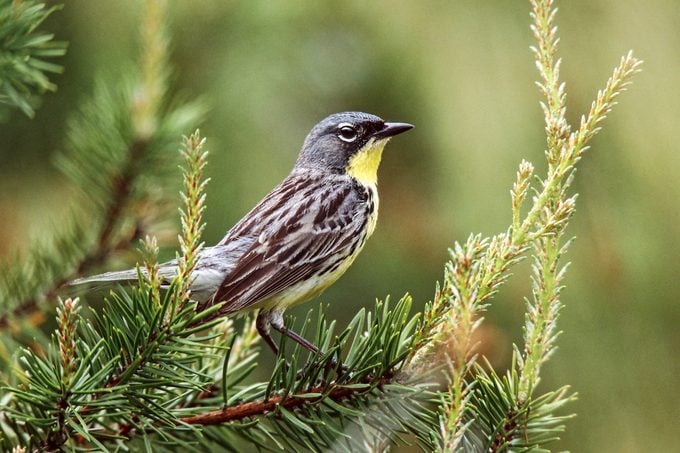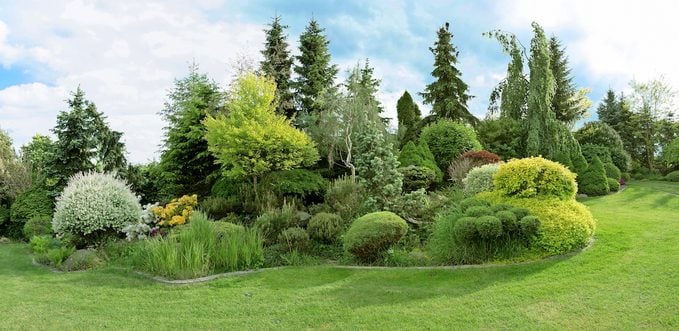The Best Types of Evergreen Trees and How to Care for Them
Updated: Nov. 28, 2023
Choose the best type of evergreen tree or shrub for your yard and learn how to keep it healthy. These evergreen tree varieties add beauty to landscapes.

Gardeners love many types of evergreen trees—especially in winter when these enduring plants offer the only living color we’re likely to see in the landscape. But the backyard classics offer benefits beyond the chilliest season: They can screen out ugly elements, lend privacy, provide a backdrop for other plants and block strong winds.
“A screen of evergreen trees can be utilized to provide a windbreak around homes, which can reduce both winter heating and summer cooling costs,” says Paul Tauke, forester for the city of Ames, Iowa, and former chief of the Iowa Department of Natural Resources’ Forestry Bureau. “Placing evergreens on the north and west sides of the property provides the most effective wind protection.”
Evergreens aren’t just beloved by humans—backyard visitors adore them, too. Birdscaping, or growing plants for bird habitat, is an easy way to attract more wildlife.
“The primary wildlife benefits of evergreens are winter protection and nesting habitat,” Paul says. He notes that spruces and pines provide excellent cover for birds and that evergreens with edible cones, such as eastern red cedars, are a valuable food source, especially to waxwings. Just consider what types of evergreen trees could be invasive in your region. Paul points out that an eastern red cedar’s seeds are spread through birds and are often considered invasive in prairie, grassland and pasture situations. Learn why you should plant eastern red cedar trees in your yard, if they’re native to your area.
Types of Evergreen Trees for Landscaping
Although a couple types evergreen trees are broadleaf (meaning their foliage looks more like a traditional leaf), needled conifers, including pine, spruce and fir, have more value to wildlife. Paul’s favorites are white spruce, Norway spruce, concolor fir, white pine, Leyland cypress and arborvitae, but he says to avoid planting Austrian or Scotch pine, both of which can have serious diseases.
“Because of tree diseases like cytospora canker and rhizosphaera needle cast, Colorado blue spruce should also be avoided in windbreaks and in any other areas where airflow through the tree is restricted by structures or other trees,” Paul says.
There are great evergreens for many different conditions and spaces. As a bonus, many standard-sized types of evergreen trees are now available in space-saving dwarf or columnar form. See our top 10 dwarf evergreens for small spaces.
Pick a Location for Evergreen Trees
After you choose a tree or shrub, pay attention to where you plan to grow it.
“As a general rule, evergreens do not tolerate wet feet, so place them in areas where the soil has good drainage,” Paul says. “Be aware that many residential urban sites may have had the topsoil removed in the land development process. If this is the case, any tree that’s planted could be put in clay soil. Clay soils are typically poorly draining, so evergreens may find it difficult to thrive.”
Here’s another option that’s more moisture-proof: bald cypress. It’s a deciduous conifer that masquerades as an evergreen until fall, when it changes color and drops its needles.
First, read these seven things you need to know before planting a tree. When planting any evergreen, dig a hole just as deep as the root ball (so the root flair is even with the soil surface), but twice as wide. Then backfill with the excavated soil, not amended soil. “Research shows that adding gravel, sand or black dirt in the planting hole does not improve drainage and is detrimental to the tree,” Paul says.
Check out the 8 types of Christmas trees you can grow.
Types of Evergreen Trees for Tough Spots
The University of Minnesota Extension suggests these types of evergreen trees for difficult conditions.
Clay soil: arborvitae, ponderosa pine, white fir
Sandy soil: mugo pine, many junipers
Wet soil: American arborvitae, balsam fir, black spruce
High pH: arborvitae, Black Hills spruce, mugo pine, ponderosa pine
Windy areas: jack pine, red pine, ponderosa pine, Rocky Mountain juniper, savin juniper, Douglas fir
Partial sun: arborvitae, balsam fir, Douglas fir
Shade: Canada hemlock, Canada yew, Japanese yew
Psst—if you’re not concerned about growing conditions, try these small evergreen shrubs to grow for year-round beauty.
How Much to Water Evergreen Trees
Unlike deciduous trees, there’s rarely a need to rake around the base of the tree or to prune evergreen trees. Instead, focus on water.
“Evergreens typically need more supplemental watering than deciduous trees in the first few years following planting. Especially if the weather turns hot and dry,” says Paul, who manages 15,000 trees. Look at the diameter of the tree trunk to know how much water you need—use 10 gallons for every inch.
But be cautious of overwatering. Stick your finger a few inches into the ground to feel if the soil is crumbly. If it feels dry, then it’s time to water.
Check out 7 ways to conserve water in the garden.
Taking Care of Evergreen Trees
After planting, most types of evergreen trees are generally easy to maintain. Just remember two things: Mulch and do not fertilize.
Mulching conserves moisture and keeps roots cool. Leave a saucer-sized space near the base of the tree clear of mulch. This keeps material away from the trunk, protecting the base of the tree from pests and disease.
There’s no need to fertilize newly planted evergreen trees. “Most fertilizers contain nitrogen and that stimulates leaf or needle growth,” Paul says. “Typically, newly planted trees need to reestablish roots that were lost in the transplanting process, so using nitrogen in the first two or three years after planting can stimulate top growth before an adequate root system has developed. This could lead to the tree drying out if weather turns hot and dry.”
Learn why you should avoid dyed mulch in the garden.
If you follow these tips, your trees and shrubs will reward you—and the wild birds—for years to come.





















